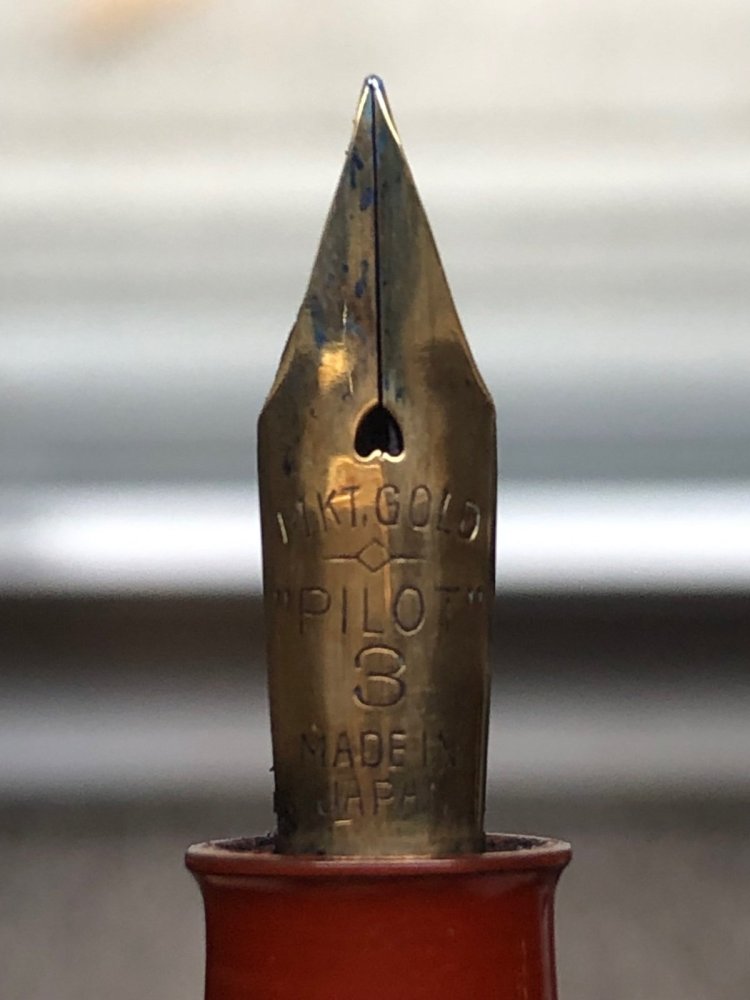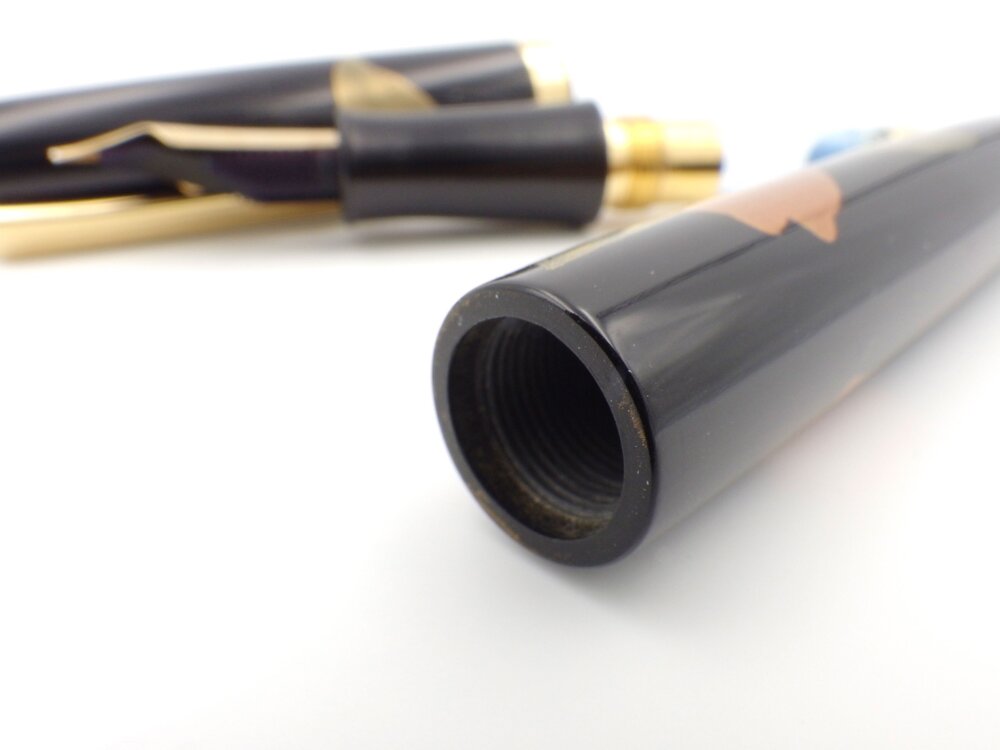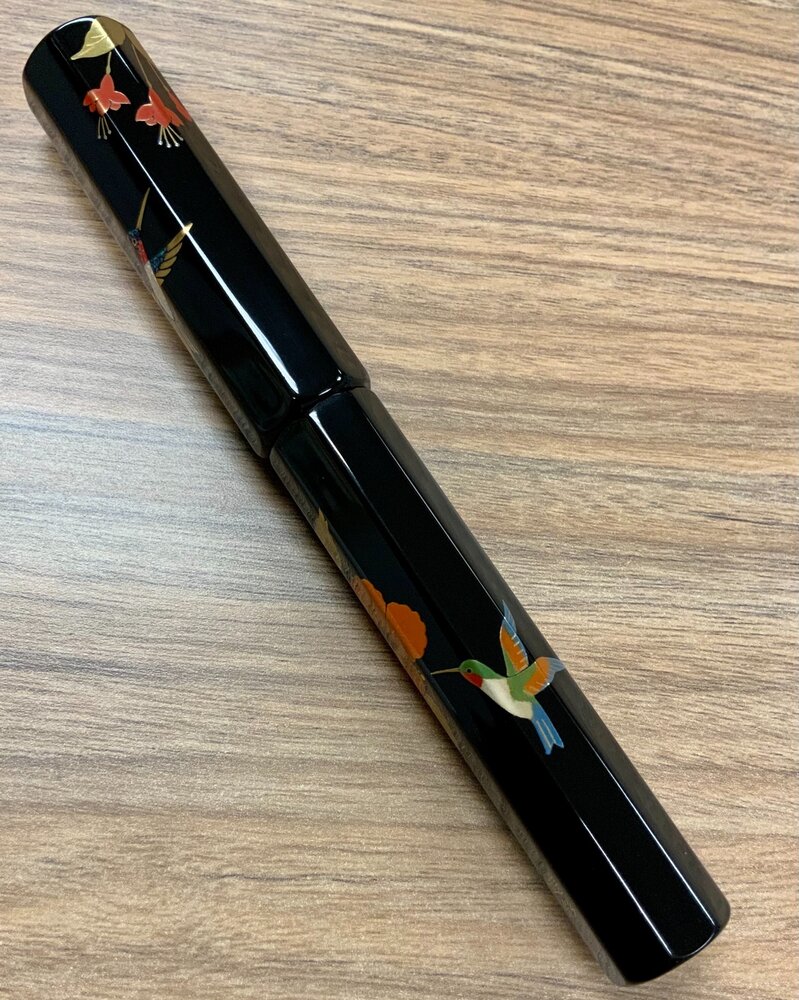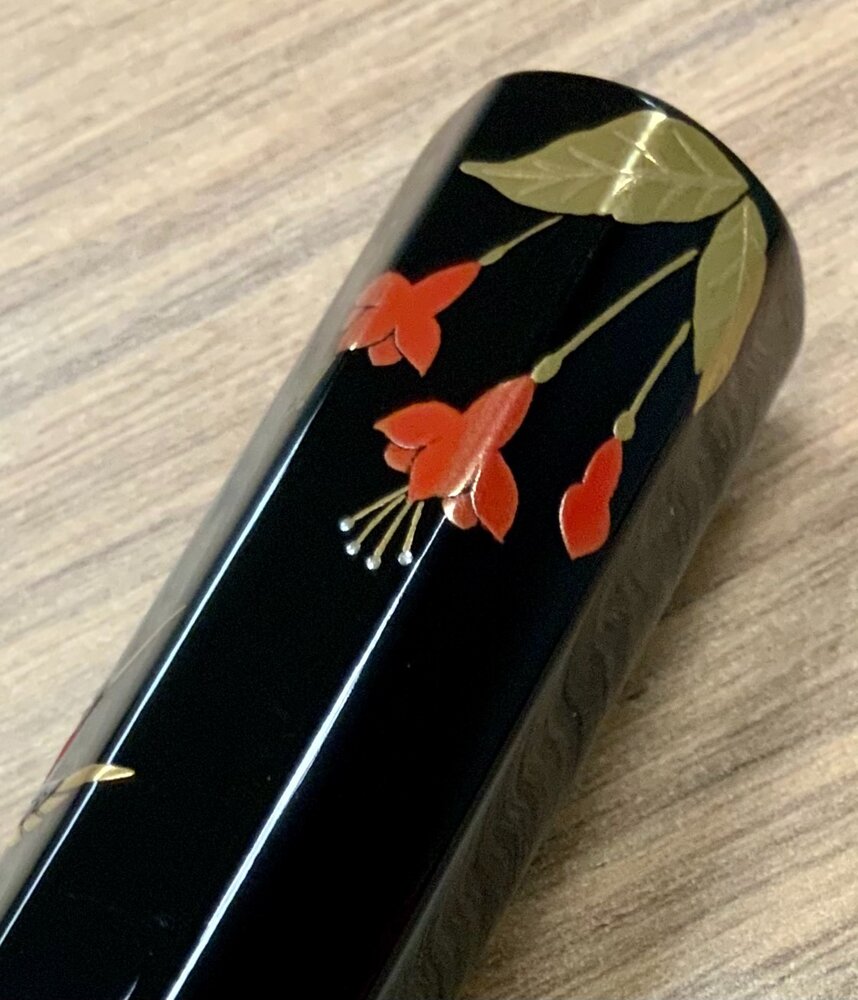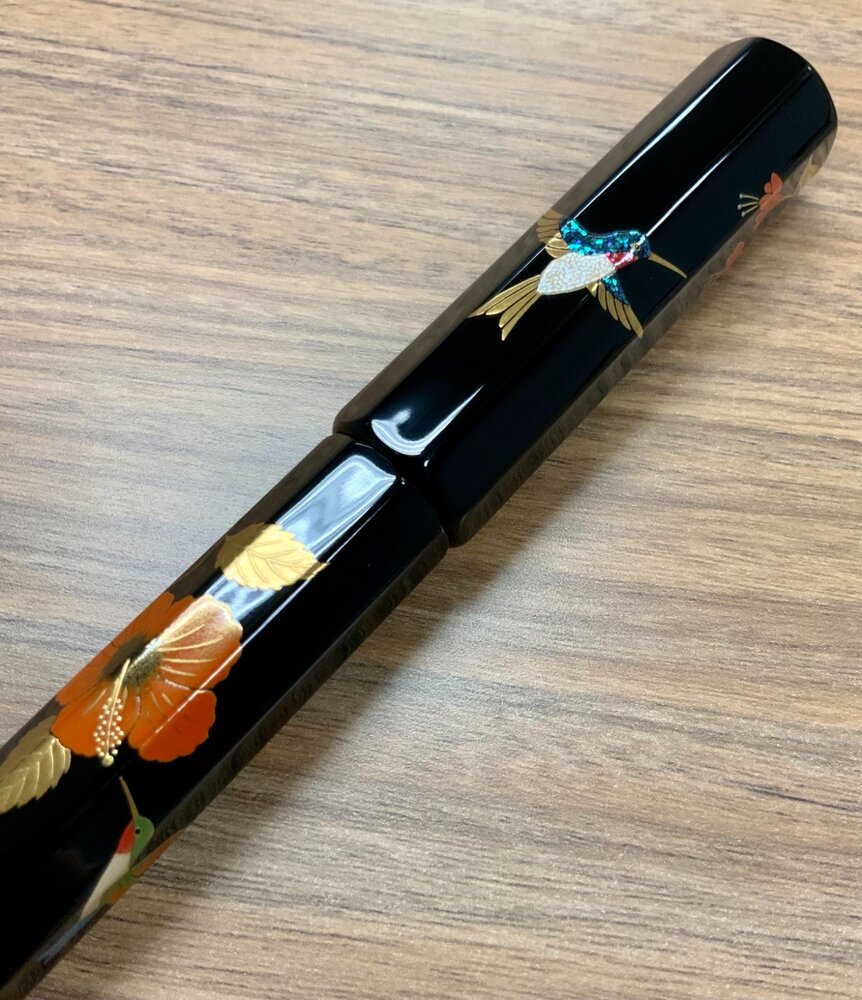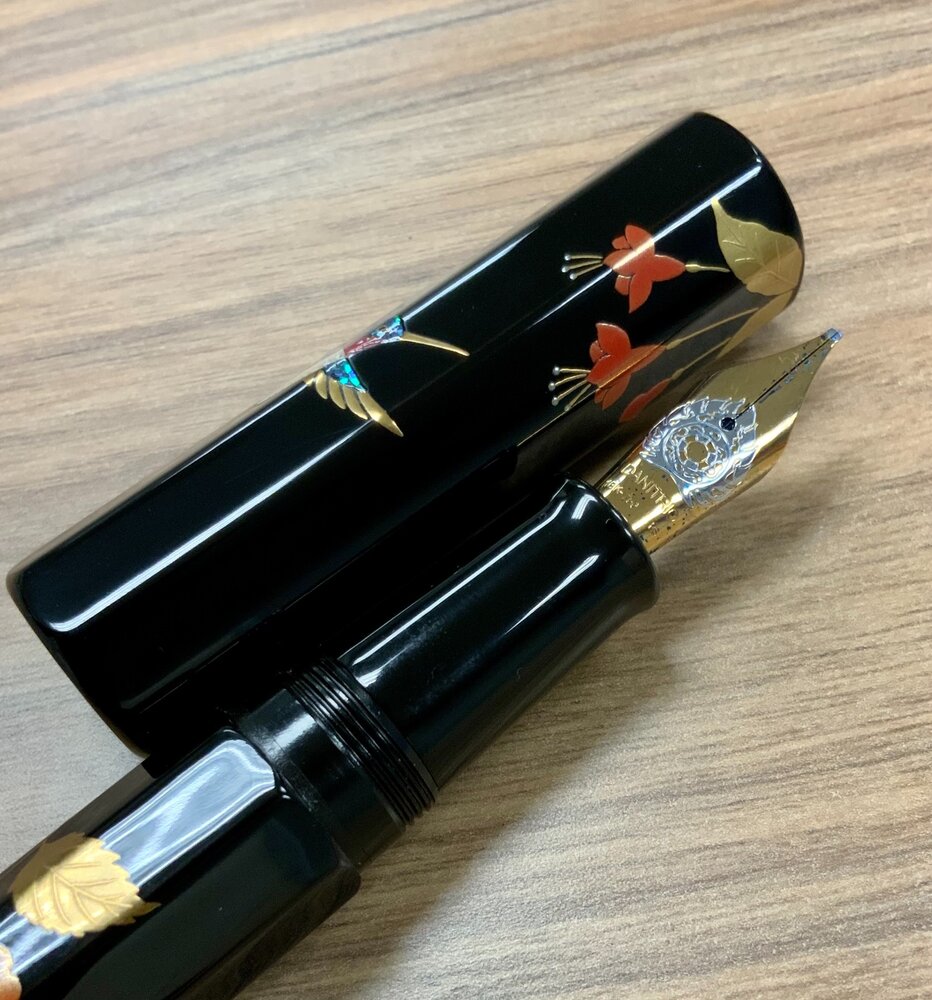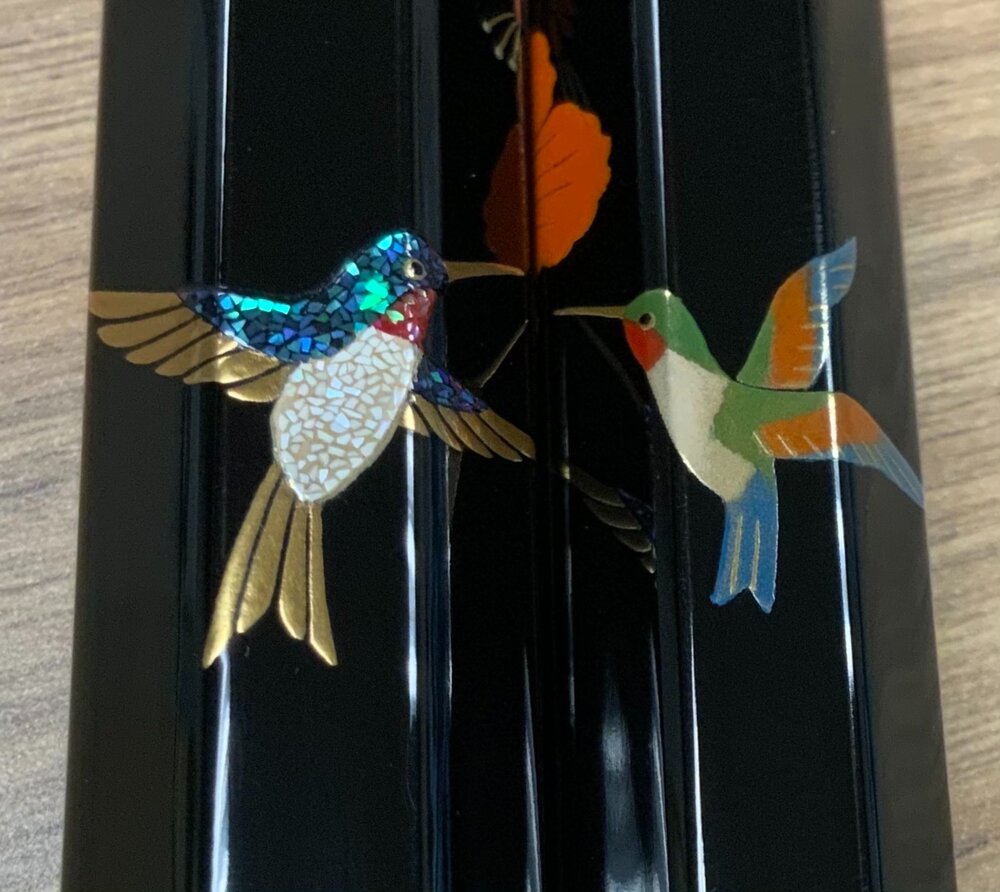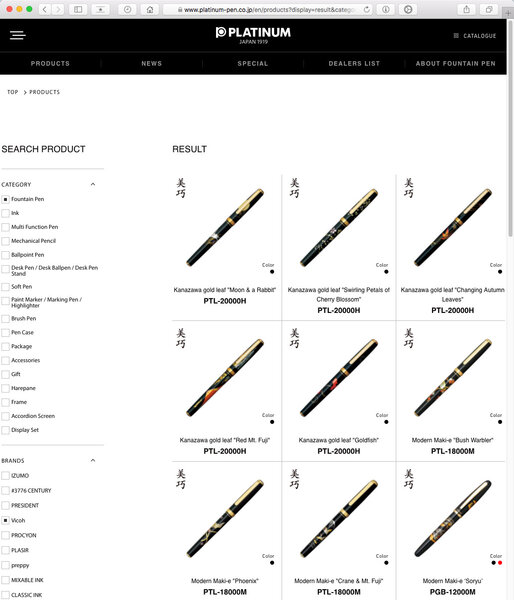Search the Community
Showing results for tags 'maki-e'.
-
Anyone know what this is? There is no branding aside from the nib and the clip is broken off… can’t seem to find any records of a Namiki that looks like this or similar.
-
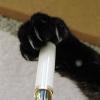
Urushi Studio India Goldfish pen impressions and comparisons
jandrese posted a topic in India & Subcontinent (Asia)
I collect urushi and maki-e pens some of which are from India. Here is my Urushi Studio India Goldfish pen impressions and comparisons. First, I show below photos of the pen by itself then photos alongside Japanese pens with the same theme. 398CB59A-8CF7-4757-86E2-23AC7032FC21 by Ja Ja, on Flickr DDD9A3DA-A5A4-482E-87B8-EB2F9251CDF4 by Ja Ja, on Flickr 0AB601B8-1C2D-4B71-8201-AAB972792F21 by Ja Ja, on Flickr 2BE10825-8A09-4EE9-AE61-0F210CF727A9 by Ja Ja, on Flickr D0113742-49BC-4DC8-B125-F1D9C168B868 by Ja Ja, on Flickr Overall, the Urushi Studio India pen is an attractive and unique take on the traditional kingyo (goldfish) theme. The blue base color is remarkable for both the seeming obviousness of using blue when the Japanese use black, and for the difficulty of producing blue urushi. The rocks and goldfish are pleasantly raised urushi especially so the goldfish—the technique is subtle reminding one of the shishiai-togidashi maki-e oft used by Japanese artists when painting kingyo. Comparing the work to three examples of kingyo theme pens from Japanese manufacturers provides some informative contrasts. The three Japanese works are a Danitrio Hyotan by Yusai, a Stylo Art pen featuring Wajima-nuri, and a Namiki Emperor by Seiki. In ascending order of retail price the pens are Urushi Studio India, Stylo Art, Danitrio, and Namiki. The Stylo Art pen is priced only about 15% more than the Urushi Studio India pen whereas the Danitrio is ~2-fold the price and the Namiki tops the scales at nearly 10-fold. 1ED931C6-FA40-4F1A-B873-B8AC7EBE52B5 by Ja Ja, on Flickr The base color of all three Japanese pens is black, that is, polished black oil-free urushi (kuro roiro). The polished black base is highly traditional, glossy, and has a preternatural sense of depth. The Danitrio pen makes this finish a feature, which works well with the curvy shape of the pen, showcasing the perfection of the finish. The other two Japanese pens make use of the black surface more as backdrop for subsequent maki-e work. The black contrasts with the colorful maki-e work but being black does so equally for all colors. Black and gold can also combine to look brown-ish or form a stunningly rich contrast. The polished blue of the Indian pen immediately signals a non-traditional approach while the glossiness of the finish advances its quality. It is said that obtaining consistent blue urushi finishes are difficult so those in the know may appreciate some added difficulty in the preparing the base finish. There are, however, spots of inconsistency in color/gloss speed throughout the blue base coat that are apparent on close inspection. The blue color suggests a realistic depiction of an underwater scene although a more naturalistic color scheme would make use muted earth tones. Being opposite on the color wheel from orange the blue base forms a strong color contrast with the colors used on the goldfish. This is simultaneously attractive and sharply obvious. 21646BA8-3343-4208-9435-A29197FC664D by Ja Ja, on Flickr A bed of rocks are key elements on both the Urushi Studio India pen and the Namiki Emperor. On the Namiki the results are splendid with a multilayered, multicolored believably realistic depiction of a rocky bottom interspersed with foliage. Many maki-e techniques are on display including raised and polished work, multiple metal powder gradients, colored urushi, nashiji, and kirigane (inlaid gold foils). The Urushi Studio India pen also uses multi layered maki-e to depict the rocks yet has a comparative lack of details. The rocks are thickly layered rendered in black with a simple gradient of silver metal particles the texture of which can still be felt. The Namiki better integrates foliage amongst the rock and extends the subsurface to the very end of the pen with nashiji whereas the Urushi Studio India pen leaves a tip of blue at the end of the pen. 2A355D6C-A762-4827-8F2D-92AFAD973A7B by Ja Ja, on Flickr All four pens employ depictions of aquatic plants with the Namiki and Danitrio elevating the work to the highest levels. This is especially so on the Namiki but the clever placement of the plants on the Danitrio along with the the thickness of the lines as well as their subtle color shifts indicate high quality workmanship. The plants are more two dimensional on the Stylo Art pen but the shapes and colors are in keeping with the Namiki and Danitrio pens. The Urushi Studio India pen takes some liberties with its depiction of aquatic plants. The centerpiece looks more like a coral than a freshwater species and the overall color scheme is not as cohesive. The plant colors include silver, red, green, pink, and yellow that lack a sense of being clearly freshwater species that live in the same environment. Two of the pens use bubbles to enhance the underwater scene whereas the other two use gold particles. The bubbles on the Danitrio are rendered with raden, which adds to the visual and textural complexity. On the Urushi Studio India pen the bubbles are silver circles. Rendering the bubbles on the Danitrio is both a higher skill and a more time consuming process. On the Stylo Art and Namiki pens gold particles are used to indicate sand, texture, particles suspended in the water column, and light (the Namiki adds silver particles to enhance the sense of light). The maki-e work on these two pens adds a great deal of dimensionality and dynamism to the scene that is lacking on the less complex pens. 5A787263-2B46-4780-836B-A4F92E5238E5 by Ja Ja, on Flickr Now for the main attraction, the goldfish or kingyo. These pens depict Wakin kingyo, which is the most common kind of Japanese goldfish and the one that forms the basis for all the other types. Kingyo traditionally symbolize wealth, prosperity, and abundance. The red and shimmering gold colors of the goldfish are Summer colors as is green and blue. All four pens offer different depictions of the goldfish. Namiki’s is the most complex visually and artistically. The color scheme of the Danitrio goldfish matches that of the Namiki, and the artwork is similarly delicately raised but the overall approach on the Danitrio is less involved. The fish on the Stylo Art and Urushi Studio India pen are similar to each other although the Stylo Art proves the richer and more complex execution. FF8D6A9A-7FBF-4C15-8031-14E482642850 by Ja Ja, on Flickr Focusing just on the Urushi Studio India pen the goldfish are not shiny as they are on the other three pens. At the risk of anthropomorphizing the goldfish the expression is a frown on the Urushi Studio India pen whereas the others have a neutral expression. The scale lines and the lines on the fins are not regular, which affects the flow of the design causing the eye to wander. The Japanese work is typified by precise, regular, and delicate line work. The micro surface of the Urushi Studio India fish is uneven, which contrasts with the smoothly polished surface of the fish on the other pens. Diffuse and gradient gold particles are used on the Japanese pens to give texture and increase the color depth of the fish. The Urushi Studio India pen does not make use of gold particles except on the lines. The delicate flow of the goldfishes fins are rendered splendidly on the Namiki pen followed closely in effect by the Danitrio then the Stylo Art. The Urushi Studio India pen gives a large surface area to the fins, which is in keeping with the Namiki design but lacks the textural complexity and wispy sense of motion imparted by the Namiki and Danitrio depictions. Uniquely, the Stylo Art pen uses raden for the goldfish eyes, which is an inspired choice that elevates the artwork that otherwise lacks some of the complexity shown by the Danitrio and Namiki fish. In summary, Danitrio goes for simplicity and executes to perfection. Namiki uses complexity and executes to perfection. Neither are easy to accomplish. The Stylo Art and Urushi Studio India pens are in between those extremes although in design terms the Stylo Art is most akin to the Namiki whereas the Dantirio and the Urushi Studio India take a similar similar approach. That the Urushi Studio India pen can comfortably sit beside the Japanese works is impressive. Taken on its own, and seen with the eye not an unrelenting macro lens, the Urushi Studio India pen is a vibrant joy to behold. It has all the visual and textural appeal of good raised maki-e. Given time and increased experience no doubt the relative unevenness in design and execution will improve. It is exciting to see the development of new urushi and maki-e artists outside Japan that are creating new works in their own styles using these traditional techniques.- 11 replies
-
- urushi studio india
- urushi
-
(and 5 more)
Tagged with:
-
desaturated.thumb.gif.5cb70ef1e977aa313d11eea3616aba7d.gif)
How-to: Set, or change, personal info that others can see about me
A Smug Dill posted a blog entry in Sus Minervam docet
It helps to explore this yourself, revisiting once in a while if need be, and keep in mind where each of those personal info fields are entered. Don't leave it until the urge to change something specific to come upon you, and only then bother to ask the question! Invest the time surveying upfront, instead of waste it later waiting for an answer from nobody in particular. Most of the fields shown above are self-evident as to what they are. I think the only ones that could do with explanation are: Security and Privacy: There is only one setting under there, and that is a toggle for whether your online status (including ‘last active’ date or time) is visible to others Content View Behavior: That has nothing to do with what others can see about you, but only where you would like to start reading when accessing content Enable status updates: This toggle enables/disables the public feed on your profile page; if you disable it, then nobody (including you) can post publicly visible ‘status updates’ or any other message against your profile, but if you enable it, then anyone — friend, foe, or complete stranger — can post something there whenever, without waiting for you to initiate and then only reply to what you wrote Notification Settings have nothing to do with what others can see about you, and so is out of scope for this article, and I'm not going to delve into those right now. (You can look here, here, and here to wrap your head around how notifications work with respect to followed content.) N.B. There is a possibility that some of the above settings and data fields may not be available to Bronze members and/or Silver members, but I have no way of testing that or scoping it out. — • — Another way of getting to the Edit Profile dialog, and the way to change your profile photo (or ‘avatar’), is here: — • — Freeform, custom member titles that one enters for oneself are long gone, and have not been a thing since FPN came back from a long hiatus and platform upgrade late in 2020.-
- fight club
- salix
-
(and 101 more)
Tagged with:
- fight club
- salix
- parker 51
- jacques herbin
- bleu austral
- bleu de minuit
- graf von faber-castell
- moss green
- olive green
- deep sea green
- gulf blue
- cobalt blue
- midnight blue
- parker urban
- night sky blue
- diamine chocolate
- platinum
- vicoh
- kanazawa
- gold leaf
- maki-e
- kanazawa-haku
- modern maki-e
- slender
- feminine
- snap cap
- penbbs
- chinese ink
- lamy 2000
- aurora
- ottantotto
- aurolide
- rose gold
- 888
- limited edition
- solar system
- planets
- jupiter
- giove
- conway stewart
- cs 58
- duro nib
- 14k
- medium nib
- green
- hatched
- sheaffer
- balance
- statesman
- 14k
- fine nib
- 1930s
- sheaffer
- balance
- statesman
- 14k
- fine nib
- 1930s
- webster gold crown
- webster gold crown
- webster gold crown
- jinhao x159
- feed diameter
- size 8 nib
- my foot!
- pilot
- plumix
- ef nib
- bb nib
- stub nib
- steel nib
- pilot
- plumix
- ef nib
- bb nib
- stub nib
- steel nib
- pilot
- plumix
- ef nib
- bb nib
- stub nib
- steel nib
- space
- stationary
- planets
- rubber
- pencil
- ruler
- vjreviews
- vjreviews
- nibsmith
- dan smith
- italic
- nibsmith
- dan smith
- italic
- lamy z52
- lamy studio lx all black
- aurora ipsilon
- faber-castell essentio
- noodlers aircorp blue black
- aircorp blue black
-
Here is a focus stacked macro of the Platinum Izumo Kurikara-Ken in sumiko taka maki-e. This pen is subtly amazing. The mix of texture and contrasting finishes all in black is super cool. Best seen and felt to understand its intricacies. f2point8 stacked logo by Ja Ja, on Flickr
-
Here in full focus stacked macro glory is the limited edition Taccia Miyabi Imperial Koi. The background is, I think, byakudan-nuri whereas the fish are in rankaku with mother of pearl raden eyes. Usually, koi are not usually represented this large but Taccia made the specific choice to render them this way to good effect. Sailor nib so it writes well. focus stacked logo by Ja Ja, on Flickr focus stacked koi closeup logo by Ja Ja, on Flickr cap logo by Ja Ja, on Flickr
-

Sailor King of Pen Battle of Itsukushima LE pen and box details
jandrese posted a topic in Japan - Asia
This is the incredible Sailor King of Pen Battle of Itsukushima LE in full focus stacked macro glory. The artist is Ikki Moroiki and the total number of pens is 33. The presentation box is also incredible in black lacquer and maki-e. Details of the maki-e on the box are shown below. 8E7EBA7F-D2BE-4748-B5AF-EFB645A9EBC9 by Ja Ja, on Flickr 4FDBB95A-F8C8-4497-8026-D63CF7B90898 by Ja Ja, on Flickr 358CEAD5-FDD5-4C92-9B49-AE9CCEC83717 by Ja Ja, on Flickr- 5 replies
-
- sailor
- king of pen
-
(and 2 more)
Tagged with:
-

Some Japanese pens (and a Montegrappa) with custom maki-e by Morgan Wisser
jandrese posted a topic in Japan - Asia
I shot focus stacked macros of all these pens for Dromgooles. As far as I know they are all still currently available. Good, high relief maki-e by the French craftsman, Morgan Wisser. I have several pens customized by him and have been happy with the work. Let me know what you think or if you have any questions. focus stacked yes logo by Ja Ja, on Flickr focus stacked yes logo by Ja Ja, on Flickr focus stacked yes logo by Ja Ja, on Flickr focus stacked yes logo by Ja Ja, on Flickr turtle side focus stack yes logo by Ja Ja, on Flickr shark side focus stack yes logo by Ja Ja, on Flickr -
Here is my Pilot Maki-e Seirei-nuri pen that I purchased at Itoya in Ginza, Tokyo in full focus-stacked macro glory. I love writing with pen, which is the same form factor as a Namiki Yukari. From my 2019 post on this pen "The nib was expertly adjusted by the resident meister at Itoya and it is freaking perfect. Like, perfect. Just a light touch is needed for generous but far from gushing ink flow. The nib has the faintest hint of feedback without being intrusive. The lady working there is a savant!". Good stuff. pilot seirei nuri focus stacked yes logo by Ja Ja, on Flickr
-
This is the Namiki Yukari Royale Frog in full focus stacked macro glory. Namiki calls this motif Frog. There is more than one frog but more importantly the dynamism and joy of the piece jumps off the pen. Note the different colors of urushi and raden to depict the water. I'd call this pen Happy Frogs. Focus stacked curves up color shift yes logo by Ja Ja, on Flickr frogs focus stacked with logo by Ja Ja, on Flickr
- 4 replies
-
- namiki
- yukari royale
-
(and 3 more)
Tagged with:
-

Danitrio Mikado eyedropper pen leaked-a comparison with a Namiki Emperor
jandrese posted a topic in Japan - Asia
One of my Danitrio Mikado (eyedropper filling model) pens leaked on me at work. That is Noodler’s Navy you see on the section in the first image. I collect Danitrio and this sort of thing happens more often than I care to admit on their eyedropper filling pens. I still collect Danitrio but stopped buying eyedropper models a couple of years ago. At this point I know all the potential ways in which a Danitrio can leak. This one leaked at the junction between the section and the barrel. Naturally, with a leak like this you don’t know it’s happening until you look at your inky hand so that’s nice. There is no obvious reason for the leak, which led me to investigate further. To do so I thought a comparison to a Japanese eyedropping pen that has never leaked on me was in order. Thus, I cleaned out the Namiki Emperor I had with me at work and set about comparing the two pens. What have I learned? 1) That even compared to a Namiki Emperor the Danitrio Mikado is a big pen and looks great. Feels good to hold and to write with and that stub nib is extra nice. Seems to be on par with the Namiki on looks and feel but… 2) The section engineering and machining execution is different between the two pens. The concept is the same—eyedropper with shutoff valve—but the Namiki has some advantages. a. The Namiki threads are finer pitched and better machined inside the barrel and on the section. This can be felt when screwing in the section; there is a smoother feel and less play. b. The threaded portion of the section has a bigger diameter on the Namiki. The overall diameter is 10% greater and but the ratio between the diameter of the grip portion and the threading is also 10% greater on the Namiki. c. The o-ring on the Namiki is more precisely seated, that is, it has no room to move about. d. Both o-rings fit into a slot in the barrel that is flat and smooth before the threads start up. The slot on the Namiki is not as deep. I have a gang of Danitrio pens that fill by eyedropper. One or two have never leaked on me at the section. This pen used to be one of them. The problem is at the level of the o-ring. There is too much potential for the o-ring to move about, get twisted, or otherwise compressed in an uneven fashion. It only takes an infinitesimal gap for ink to leak. Water always finds the path of least resistance. A little side pressure from your grip and the heat from your hand is all it takes to set the leak in action. Part of loving Danitrio seems to be leak mitigation. Changing o-rings has helped in the past on other pens but o-rings that fit are not easy to come by. Danitrio themselves does not seem to have consistently sized, readily available replacement o-rings. That bit about consistently sized o-rings may make more sense knowing that there is more variability between Danitrio pens of the same model than Namiki pens of the same model. I reckon Namiki buys only one size of o-ring that always fits like it is supposed to. I admit that it all is a bit frustrating, but I press on. IMG_8517 by Ja Ja, on Flickr IMG_8529 by Ja Ja, on Flickr IMG_8535 by Ja Ja, on Flickr IMG_8539 by Ja Ja, on Flickr IMG_8541 by Ja Ja, on Flickr IMG_8543 by Ja Ja, on Flickr -
This is my Danitrio Hyotan Special edition Maki-e F-49 Blue Dragon LE. There are only 30 of these pens produced by the artist Yuji. This dragon does, however, appear on another pen, a Mikado model with more involved maki-e that retailed for far more than this pen. Untitled-1 yes logo by Ja Ja, on Flickr closeup yes logo by Ja Ja, on Flickr
-

Danitrio Maki-e Ancient Dragon with Flowers by Kogaku on Hyotan
jandrese posted a topic in Japan - Asia
I've had this pen for awhile. Since it's attractive I thought I'd capture a good picture of it. Danitrio really does tamenuri well and the curvy shape of this pen lets the light play off of the tamenuri. working image full yes logo by Ja Ja, on Flickr -
The Taccia Hyakko-Hisho II collection Sango. The Hyakko-Hisho is a collection of 100 urushi styles, a type of reference work that artists have drawn on since the Edo period. Sango means coral and this pen in kawari-nuri captures the essence of coral. A unique addition to the collection. Fitted with a Sailor Zoom nib. AC7FC6BB-687B-4FAA-A81B-A3EAC71B0CB4 by Ja Ja, on Flickr 233884EA-F18B-4476-B23D-236FA60821C8 by Ja Ja, on Flickr
-
Sailor is pleased to announce a new series of limited edition maki-e fountain pens entitled 'Dobutsu to Gekkou' or 'Animals in the Moonlight.' The first one to crown the series is the Antler Stag. Proud and without fear, he stands in the moonlight. 'Sailor Shika to Gekkou' The round moon is one big spot of mother of pearl dusted with silver powder. The background of the pen is matt and has a slight ishime structure. At first sight, it looks black, but with changing light, it turns dark green. This piece of art is executed in Togidashi Taka Makie by master Ikki Moroiki. Fifty copies for the world. We have a few pens in stock, first come first served. https://www.sakurafountainpengallery.com/en/boutique/detail/sailor-shika-to-gekkou-deer-in-moonlight-sailor-maki-e
-
- sailor
- shikatogekkou
-
(and 3 more)
Tagged with:
-
This is the new LE from Sailor, the Bespoke Maki-e King of of Pen Shika to Gekkou or Deer in Moonlight. The artwork is amazing and emotive. Feast your eyes on this focus stacked macro capture of a wonder. Untitled-1 watermarked by Ja Ja, on Flickr
- 22 replies
-

Dantrio Hakkaku with dragon Maki-e and a 18k #6 size stub nib full macro glory
jandrese posted a topic in Japan - Asia
Here I present the Dantrio Hakkaku with dragon Maki-e and a 18k #6 size stub nib. I don't know anything about this pen other than I bought it in 2017. I've never seen the design on another Danitrio pen. Danitrio does not offer any story or explanation of the artwork. I posted about this pen in the fountain pen review pages back in 2017 but since then I've gained the ability to take good photos so I'm sharing again. Let me know what you think. I could be tricking myself but the tamenuri seems to be changing in a most enjoyable way. The artwork on this pen is rather nice and involved and also makes good use of the space on the pen. _SON4588 by Ja Ja, on Flickr _SON4593 by Ja Ja, on Flickr _SON4597 by Ja Ja, on Flickr _SON4598 by Ja Ja, on Flickr _SON4599 by Ja Ja, on Flickr -

Namiki Limited Edition 2021 Coral Emperor in full macro glory
jandrese posted a topic in Japan - Asia
This is the Namiki Limited Edition 2021 Coral Emperor in full macro glory. Drink it in. This pen is above and beyond in every way possible. _SON4578 by Ja Ja, on Flickr _SON4577 by Ja Ja, on Flickr _SON4580 by Ja Ja, on Flickr _SON4582 by Ja Ja, on Flickr _SON4584 by Ja Ja, on Flickr _SON4583 by Ja Ja, on Flickr _SON4585 by Ja Ja, on Flickr _SON4586 by Ja Ja, on Flickr- 3 replies
-
- namiki
- naimki limited edition 2021
-
(and 3 more)
Tagged with:
-

Namiki Limited Edition 2021 Coral Emperor first look and writing sample
jandrese posted a topic in Japan - Asia
Here is the mighty No. 50 size Namiki Emperor in the 2021 Limited Edition Coral maki-e. Words cannot express the amazingly superlative incredibleness of this pen. I have some pretty awesome macros I can share in a followup post if anybody is interested. IMG_8256 by Ja Ja, on Flickr- 16 replies
-
- namiki
- namiki limited edition
-
(and 4 more)
Tagged with:
-
Wanted to present my current stable of Stylo Art pens. 1. Akebono/bokashi chinkin butterflies 2. Dragon maki-e 3. Pine tree and cranes maki-e The pen bodies are exclusive to Stylo Art and are large pens being slightly bigger than a Namiki Yukari but are lightweight. I believe the base material is plastic. The akebono chinkin pen has an amazing Pilot #15 nib custom ground by Yukio Nagahara to what is called an N-point. It writes a super smooth and juicy fat line at about 45 degree that gets more narrow as the pen angle is steepened. It's kinda a cross between a Sailor Zoom and Naginata grind sort of, it's doing it's own thing really. The other two pens have stock (?) Pilot stub nibs, which be warned, are really more like cursive italics. Wonderful nibs but a little more demanding than a Western stub. All come with Paulowina wood boxes, pen sleeves, and CON-70 converters. Most excellent pens and more than fairly priced. Highly recommended. capped rotated_SON3728 by Ja Ja, on Flickr capped fan_SON3729 by Ja Ja, on Flickr uncapped_SON3731 by Ja Ja, on Flickr writing sampe by Ja Ja, on Flickr
-
This is the Platinum Izumo Urokomon with cosu nib. A most excellent pen and nib. A fantastical, comfortable writer. Not a cheap pen but most impressive and indeed value for money. The display of urushi/maki-e craft is a wonder to behold. Photos do not do this pen justice. Uroko mon are diamond shaped Japanese family crests that are meant to evoke animal scales. These are hand drawn and finished in a variety of techniques. Platinum has done this pattern on several pen lines including the President, 3776, and this Izumo. The Izumo pens are really incredible sleeper hits. I have quite a few and in my opinion they are beautifully made superb writers and are value priced.
-
I thought it might be interesting to start a thread on differentiating (in a practical way) between Hira maki-e and "screened" maki-e; something I have no experience with. I only have two maki-e pens and would like to find out if any of them actually has any Hira maki-e as opposed to being silk screen entirely. I am aware the latter is probably the case since both pens were "budget" pens in their day. Here are some close-up shots (apologies for the dark shadows). I don't find it easy to single out discerning elements, any comments (or further examples) would be very much appreciated! - Platinum #3776 Tsubaki (Camellia), Lambrou's Japan book (p. 304) ca. 1982 - Pilot FK Balanced Ume (plum) (FK-3MP-UM); supposedly Kokkokai artists (?), early 1990s (?) The Platinum looks like ebonite. The Pilot is resin I believe.
-
Sharing my new Danitrio Sho-Hakkaku Hummingbirds maki-e pen with stub nib. Danitrio made some major changes in 2020. That is, they pulled pens from most retailers in the USA and started selling exclusively (?) through urushipens.com. As a Danitrio collector with a favored brick and mortar AD this move was not welcome. It did, however, give me the opportunity to purchase many other urushi and maki-e pens from other companies such as Namiki, Taccia, and more. While I’ve enjoyed expanding my horizons I was hankering for another Danitrio. I previously had dialogue with Jason at urushipens.com, and had more or less resolved to one day purchase from them, but when I saw this pen on instagram I had to have it. For one thing it was made by one my most favorite Danitrio artists, Yusai, but I had narrowly missed out on a Hyotan model with similar artwork by the same artist and was always thinking about it. A message to Jason via instagram and I was able to snag this pen before it even hit the website. It’s worth mentioning that there are no hummingbirds in Japan, they are endemic only to the Americas. Nevertheless, they are depicted in the most animated and attractive fashion on an absolutely perfect black gloss background. The flowers are no less a feature than the hummingbirds but really, the birds steal the show. There are hummingbirds where I live and we love seeing them twice a year as they migrate. The mix of technique and and artistic rendering rises to the level of the sublime. If one were so inclined this could be an exit pen. Sometimes I wish I were so inclined. The nib is a stub, which is my wont on Danitrio pens and it characteristically writes a juicy line. While I do enjoy writing with this pen for me it is a work of art. I have more than enough pens that write well. I shall never stop adding art to my life. Danitrio now has a new website and more pens are being added to urushipens.com all the time. Personally, I do not prefer to buy these types of pens online sight unseen and nib untested. In my opinion it is a poor business choice and is damaging to relationships with collectors. Urushipens.com seems like good people so I will probably continue to support them but my Danitrio collecting will dramatically slow. There are other pens I can see and touch before buying from an AD I have a long-standing relationship with. The Danitrio pens, as always, satisfy.
-
desaturated.thumb.gif.5cb70ef1e977aa313d11eea3616aba7d.gif)
Vicoh models in Platinum's online catalogues — 2019-2020 vs Dec 2020
A Smug Dill posted a gallery image in FPN Image Albums
From the album: Japanese pens
The prices of the models designated with a PTL prefix have been raised significantly by the manufacturer this year, with the Kanazawa gold leaf models going to ¥20,000+tax (up from ¥15,000+tax in Platinum's 2019–2020 catalogue) and Modern Maki-e models going to ¥18,000+tax (up from ¥12,000). The previously top-of-the-line ‘Kaga’ Hira Maki-e models (PTL-20000 with no suffix), and undecorated models (PTL-10000 and PTL-5000A) on the other end of the product line, have been discontinued. The Vicoh Sheep (PS-10000N) range was also discontinued.© Platinum Pen
- 0 B
- x
-
desaturated.thumb.gif.5cb70ef1e977aa313d11eea3616aba7d.gif)
Current line-up of Platinum Vicoh models (Dec 2020)
A Smug Dill posted a gallery image in FPN Image Albums
From the album: Japanese pens
Platinum's current line-up of Vicoh fountain pen models as of Christmas 2020.© Platinum Pen
- 0 B
- x
-
Lampyridae is a family of small beetles in the Coleoptera order with over 2000 different species. They are soft-bodied, nocturnal, winged insects commonly called fireflies or lightning bugs because of their very conspicuous use of bioluminescence during twilight to attract mates or prey. The firefly is a very well known symbol of Summer in Japan. The Sailor Taki-to-Hotaru is an unexpected fifth pen in the Taki-to-Shizen series featuring a summer evening with a crescent moon in mother of pearl shining over the waterfall. Several fireflies are enlightened in the reed, creating a magical path for prey and mates. Limited edition of 38 pcs worldwide! Reserve yours now; we'll have a few in stock! https://www.sakurafountainpengallery.com/en/boutique/detail/new-sailor-taki-to-hotaru-waterfall-and-firefly-sailor-limited-edition
-
- take-to-hotaru
- sailor
-
(and 3 more)
Tagged with:


